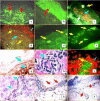Presence of neutrophil extracellular traps and antineutrophil cytoplasmic antibodies associated with vasculitides
- PMID: 22666713
- PMCID: PMC3364632
Presence of neutrophil extracellular traps and antineutrophil cytoplasmic antibodies associated with vasculitides
Abstract
Context: Anti-neutrophil p-ANCA antibodies are directed against antigens in the peripheral cytoplasm of both neutrophilic granulocytes and monocytes. They are detected in several autoimmune disorders and are particularly associated with systemic vasculitis.
Case report: We report a case of a 54-year-old female presenting with a pruritic rash, including purpura and diffuse erythema. A biopsy with hematoxylin and eosin (H & E) analysis, direct immunofluorescence (DIF), immunohistochemistry (IHC) and enzyme-linked immunosorbent assays for ANCAs were performed. The H & E staining demonstrated leukocytoclastic vasculitis, with focal vascular fibrinoid necrosis. The DIF revealed evidence of vasculitis, the presence of p-ANCAs and neutrophil extracellular traps (NETs). The IHC displayed autoreactivity to myeloperoxidase within the vessels. The IHC aided in ruling out any intrinsic autofluorescence of the vessels.
Conclusions: By observing the deposition of neutrophil extracellular traps and myeloperoxidase in inflamed skin vessels, biopsy analysis may alert physicians for rapid therapeutic intervention in patients presenting with possible vasculitides.
Keywords: IgD; Vasculitis; myeloperoxidase; neutrophil extracellular traps (NETs); p-ANCA; skin.
Figures


References
-
- Radice A, Sinico RA. Antineutrophil cytoplasmic antibodies (ANCA) Autoimmunity. 2005;38:93–103. - PubMed
-
- Carlson JA, Ng BT, Chen KR. Cutaneous vasculitis update: diagnostic criteria, classification, epidemiology, etiology, pathogenesis, evaluation and prognosis. Am J Dermatopathol. 2005;27:504–528. - PubMed
-
- Reumaux D, Duthilleul P, Roos D. Pathogenesis of diseases associated with antineutrophil cytoplasm autoantibodies. Hum Immunol. 2004;65:1–12. - PubMed
-
- Kain R, Matsui K, Exner M, Binder S, Schaffner G, Sommer EM, Kerjaschki D. A novel class of autoantigens of anti-neutrophil cytoplasmic antibodies in necrotizing and crescentic glomerulonephritis: the lysosomal membrane glycoprotein h-lamp-2 in neutrophil granulocytes and a related membrane protein in glomerular endothelial cells. J Exp Med. 1995;181:585–597. - PMC - PubMed
-
- Henry JB. 19th ed. Vol. 1556. Philadelphia: W.B. Saunders; 1996. Clinical Diagnosis and Management by Laboratory Methods; pp. 992–993.
Publication types
LinkOut - more resources
Full Text Sources
Research Materials
